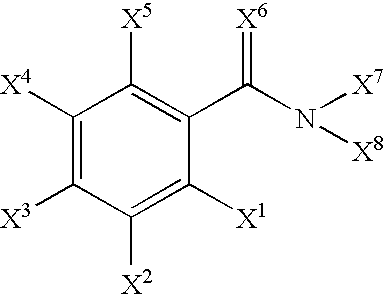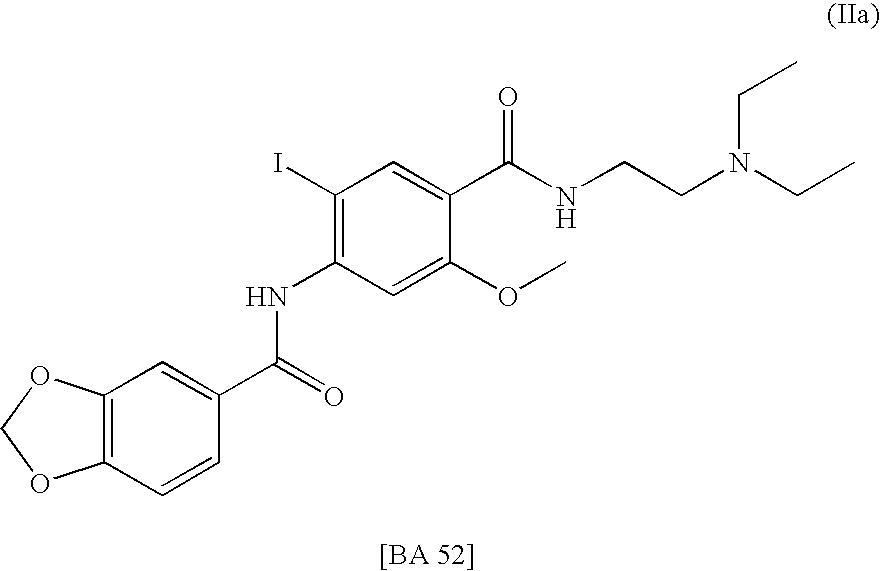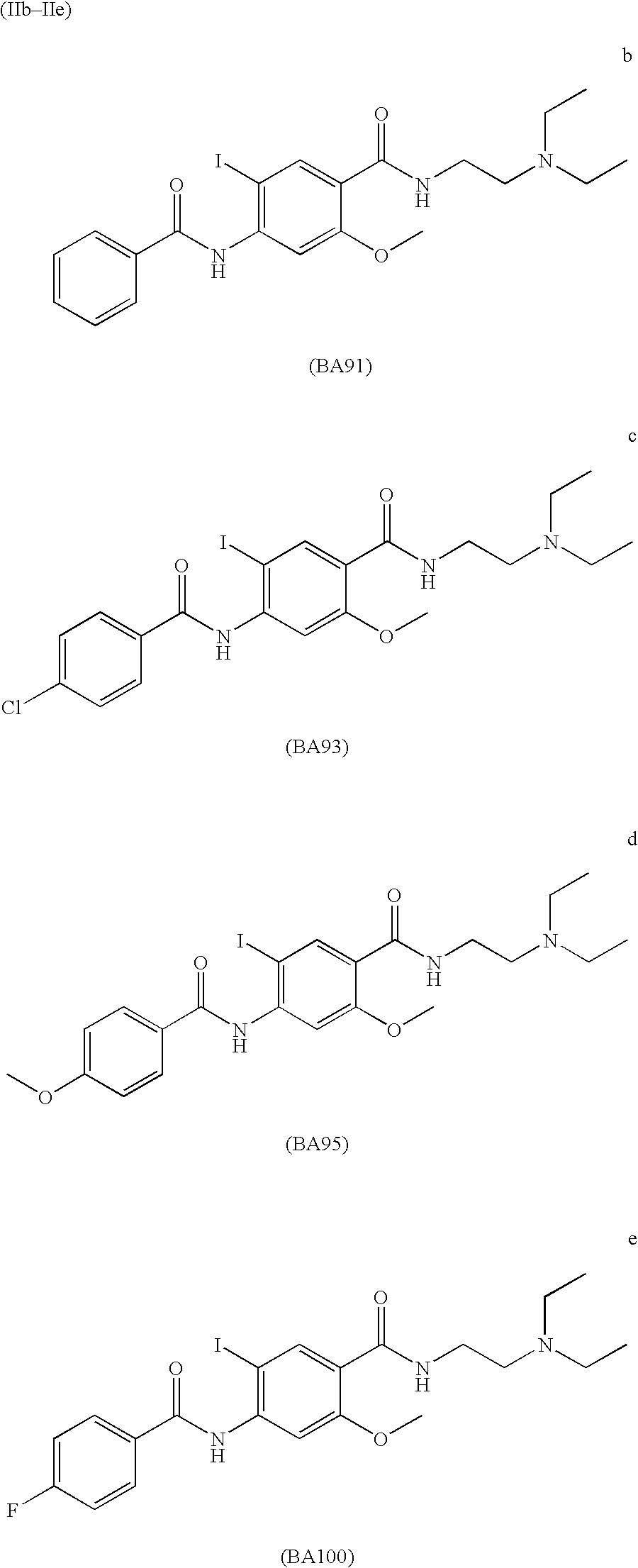Radiohalogenated benzamide derivatives and their use in tumor diagnosis and tumor therapy
a technology of benzamide derivatives and radiohalogenated benzamide, which is applied in the direction of therapy, group 3/13 element organic compounds, drug compositions, etc., can solve the problems of inability to apply, inability to find suitable therapeutically relevant isotope pairs, and inability to achieve immunotherapy and gene therapy. the success of the treatment of dacarbazin® by itself or dartmouth protocol,
- Summary
- Abstract
- Description
- Claims
- Application Information
AI Technical Summary
Benefits of technology
Problems solved by technology
Method used
Image
Examples
example 1
4-Propionylamino-N-(2-diethylamino-ethyl)-2-methoxy-benzamide
[0113]
a.) 2-Hydroxy-4-nitro-benzoic acid methyl ester
[0114]
[0115]916 mg (5 mmol) of 2-hydroxy-4-nitro-benzoic acid is dissolved in a mixture that consists of 8 ml of methanol and 32 ml of toluene, and it is slowly mixed with a solution of trimethylsilyldiazomethane in hexane (2 molar). After the addition is completed, stirring is continued for 1.25 hours at room temperature. After the reaction mixture is concentrated by evaporation, 1 g (about 100% of theory) of 2-hydroxy-4-nitro-benzoic acid methyl ester is obtained.
b.) 2-Methoxy-4-nitro-benzoic acid methyl ester
[0116]
[0117]788 mg (4 mmol) of 2-hydroxy-4-nitro-benzoic acid methyl ester is mixed in 20 ml of absolute dimethylformamide with 177 mg of sodium hydride (60%; 4.4 mmol), and it is heated for 1 hour to 50° C. After cooling to room temperature, it is mixed with 625 mg (4.4 mmol) of methyl iodide and heated for 4 hours to a bath temperature of 80° C. After concentrat...
example 2
[0130]
Benzo[1,3]dioxole-5-carboxylic acid [4-(2-diethylamino-ethylcarbamoyl)-5-methoxy-phenyl]-amide
[0131]200 mg (0.75 mmol) of 4-amino-N-(2-diethylamino-ethyl)-2-methoxy-benzamide in 10 ml of chloroform is mixed with 5 ml of 3,4-methylenedioxybenzoic acid chloride (in chloroform) and this mixture is stirred for 3 hours at room temperature. After concentration by evaporation in a vacuum, the residue is taken up in 40 ml of dilute sodium bicarbonate solution and then extracted with 40 ml of methylene chloride. The methylene chloride phase is washed with water, dried, filtered and concentrated by evaporation. The crude product, 315 mg, is taken up in methylene chloride and purified on silica gel. As a mobile solvent, a mixture that consists of methylene chloride / methanol (97:3→90:10) is used. 210 mg (67% of theory) of benzo[1,3]dioxole-5-carboxylic acid [4-(2-diethylamino-ethylcarbamoyl)-5-methoxy-phenyl]-amide (melting point 131.1° C.) is obtained.
[0132]Produced analogously are: benz...
example 3
[0133]
N-(2-Diethylamino-ethyl) 2-methoxy-4-(2-morpholin-4-yl-acetylamino)-benzamide
[0134]530 mg (2 mmol) of 4-amino-N-(2-diethylamino-ethyl)-2-methoxy-benzamide is mixed at 4° C. in 24 ml of toluene with 1 ml of trimethylaluminum (2-molar in toluene), and it is stirred for 0.5 hour at room temperature. Then, 320 mg (2 mmol) of methyl-N-morpholinoacetate is added to the batch, and it is heated for 1 hour to 120° C. 50 ml of dilute sodium carbonate solution is then added, and it is extracted three times with 50 ml each of ethyl acetate. The ethyl acetate phase is washed with water, dried, filtered and concentrated by evaporation. The residue is chromatographed on 10 g of Isolute NH2 (50 μm) with a gradient from hexane to hexane: methylene chloride=5:95 as an eluant, and 157 mg (20% of theory) of N-(2-diethylamino-ethyl)-2-methoxy-4-(2-morpholin-4-yl-acetylamino)-benzamide is obtained as an oil.
PUM
| Property | Measurement | Unit |
|---|---|---|
| temperatures | aaaaa | aaaaa |
| temperatures | aaaaa | aaaaa |
| temperatures | aaaaa | aaaaa |
Abstract
Description
Claims
Application Information
 Login to View More
Login to View More - R&D
- Intellectual Property
- Life Sciences
- Materials
- Tech Scout
- Unparalleled Data Quality
- Higher Quality Content
- 60% Fewer Hallucinations
Browse by: Latest US Patents, China's latest patents, Technical Efficacy Thesaurus, Application Domain, Technology Topic, Popular Technical Reports.
© 2025 PatSnap. All rights reserved.Legal|Privacy policy|Modern Slavery Act Transparency Statement|Sitemap|About US| Contact US: help@patsnap.com



